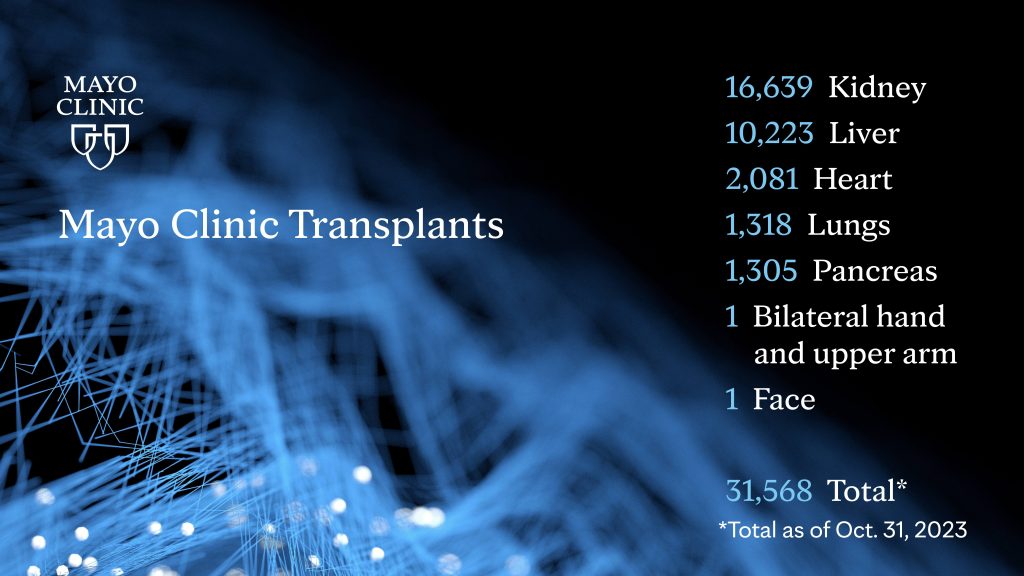-
health and wellness
ROCHESTER, Minn. — Even though the U.S. had a record year for organ donations last year, estimates 17 people die every day Waiting for transplant. But Mayo Clinic transplant experts are optimistic that solutions to some of transplant’s biggest challenges are on the horizon, thanks to new technology, research and innovation.
Video: Dr. Bersin Tanner talks about opening organ transplant clinic at Mayo Clinic
“Our goal is to transform transplant practices for future patients. To do this, we leverage technology and team science to optimize donated organs and help patients reduce rejection.” “We’re looking at ways to free people from drugs and make donated organs last longer,” he says. Dr. Barsin Tannerdirector of the Mayo Clinic Transplant Center in Florida.
Mayo Clinic celebrates 60th anniversaryth Mayo Clinic is celebrating the anniversary of its first organ transplant, a kidney from a living donor on November 25, 1963. Today, Mayo Clinic is the largest comprehensive transplant center in the United States. Mayo Clinic’s transplant centers in Arizona, Florida and Minnesota have a combined track record of more than a year. The number of organ transplants is 31,000.

“Organ transplants have been exciting from the beginning because they allow patients with end-stage organ failure and suffering from severe illness to return to normal lives. We need to achieve that,” he says. Dr. Julie HeinbachDirector of the Mayo Clinic Transplant Center in Minnesota.
Watch: Dr. Julie Heimbach talks about new advances
Journalists: Broadcast quality sound bites from Dr. Tanner and Dr. Heimbach are available in the downloads at the end of the post. Courtesy: “Mayo Clinic News Network.”Super Name/CG: Burcin Taner, MD/Transplant Surgery/Mayo Clinic and Dr. Julie Heimbach / Transplant Surgery / Mayo Clinic
Here are four ways transplants can change.
1. Enable more donor organs to be used safely.
New technology is ensuring that more donated organs reach those who desperately need them. One of the biggest advances is organ perfusion systems. These mechanical devices allow donor organs such as lungs, hearts, kidneys, and livers to survive and be used for long periods outside the body. Surgeons can also restore organs that are unsafe to transplant. “Organ perfusion techniques have helped expand the donor pool and provide life-saving transplants to more patients, while preserving some of the best outcomes,” he says. Dr. Bashar Aquel, Director of the Mayo Clinic Transplant Center in Arizona.
2. We will help ensure that your transplant lasts a long time.
The average duration of a kidney transplant in the United States is 10 to 20 years, and transplant recipients often face the need for a second transplant. But what if donated organs could live longer? Researchers are looking at ways to keep patients healthy so these donated organs can thrive longer. For example, one of the most common causes of kidney failure is obesity-related diabetes. One innovative approach is to perform bariatric surgery before kidney transplantation to reduce the chance of post-transplant diabetes. Efforts are also being made to improve how organs are matched to patients, with the aim of minimizing the need for immunosuppressive drugs, which can have negative side effects.
3. Identify organ failure early.
The earlier a person is identified as being at risk for organ failure, the sooner treatment can begin in the hope of delaying and possibly preventing the need for a transplant. Researchers are exploring ways to use artificial intelligence and blood biomarkers to identify subtle warning signs that this is happening early on.
Four. New organs created by bioengineering.
It may sound like science fiction, but experts hope that one day we will develop a way to make new organs. regenerative medicine. This would eliminate uncertainty and long waiting lists for organ donation. These efforts are still in their early stages.
All of these potential advances offer hope, but choosing to become an organ donor is a step people can take today to save more lives. More than 103,000 people are on transplant waiting lists in the United States, according to . Unified network for organ sharing. Lifestyle donation It allows you to donate part of your kidney or liver to someone in need.humans can too register Becoming a deceased donor.
###
About Mayo Clinic
mayo clinic is a nonprofit organization committed to innovation in clinical practice, education, and research, providing compassion, expertise, and answers to all who need healing. For more Mayo Clinic news, visit Mayo Clinic News Network.
Media contact:
relevant content

